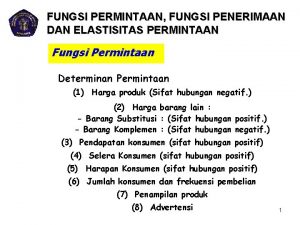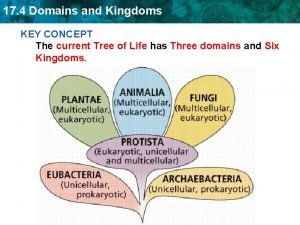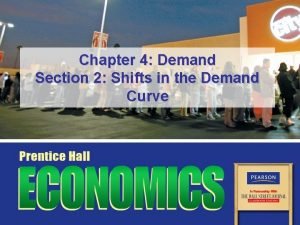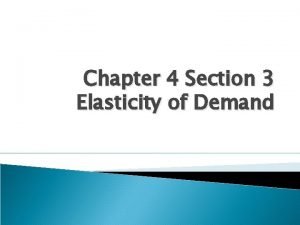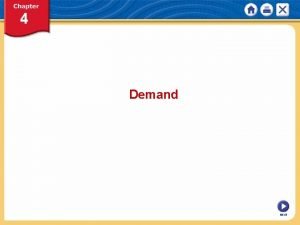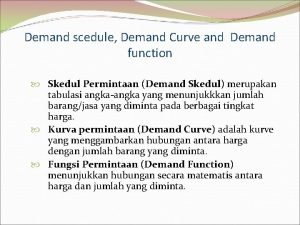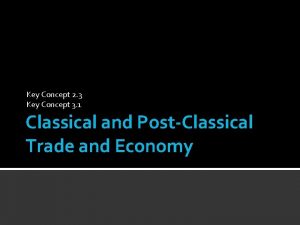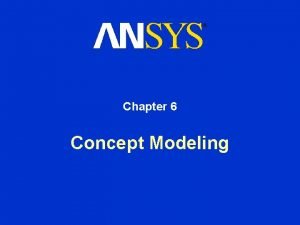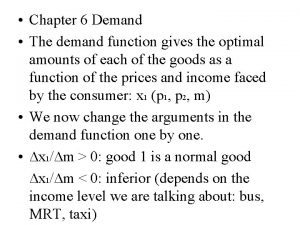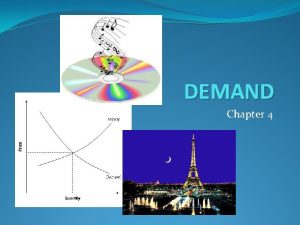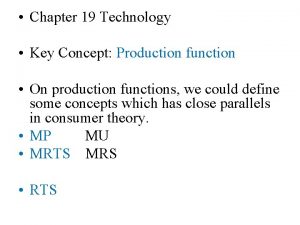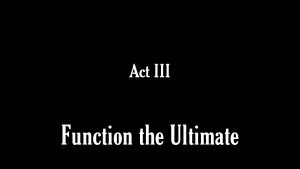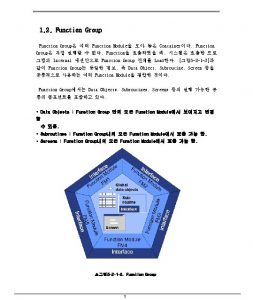Chapter 6 Demand Key Concept the demand function














































- Slides: 46

• Chapter 6 Demand • Key Concept: the demand function x 1 (p 1, p 2, m) • Income m: normal good, inferior good • Own price p 1: Giffen good, ordinary good • Other price p 2: substitute, complement

• Chapter 6 Demand • The demand function x 1 (p 1, p 2, m) • gives the optimal amounts of each of the goods as a function of • the prices and income faced by the consumer.

• x 1 (p 1, p 2, m) • We now change the arguments in the demand function one by one.

• ∆x 1/∆m > 0: a normal good ∆x 1/∆m < 0: an inferior good • It depends on the income level we are talking about. • bus, MRT, taxi



• Two ways to look at the same thing. • (1) At x 1 – x 2 space, connect the optimal bundles as the budget line shifts. This is called the income offer curve (IOC). • (2) At x 1 – m space, connect the optimal x 1 as the income changes. This is called the Engel curve.

• Draw a general preference to illustrate the income offer curve and the Engel curve.

m 2 m 1 m 2

• Look at specific preferences.

• Perfect substitutes • p 1 < p 2 • IOC (x axis) • Engel (sloped p 1)


• Perfect complements • IOC (at the corner) • Engel (sloped p 1+ p 2)


• Cobb-Douglas • • x 1 = am/ p 1 and x 2 = (1 -a)m/ p 2 so x 1/x 2 is constant at ap 2/ (1 -a)p 1 IOC (line from origin) Engel (sloped p 1/a)


• Notice any similarity among the three cases? • In the above three cases, m=c x 1. • (∆x 1/ x 1) / (∆m/m) • = (1/c) / (1/c) • =1

• They all are homothetic preferences. • If (x 1, x 2) w (y 1, y 2), then for all t >0 • (tx 1, tx 2) w (ty 1, ty 2) • (無異曲線等比例放大縮小)

• We want to show if (x 1, x 2) is optimal at m, then (tx 1, tx 2) is optimal at tm. • If we double the income, we just double everything.

• If (x 1, x 2) is optimal at m, then (tx 1, tx 2) is optimal at tm. • We care about the ratio of good 1 to good 2. (x 1, x 2) w (y 1, y 2) ↔ (tx 1, tx 2) w (ty 1, ty 2) • If we have found an optimal ratio, we just keep it when income is changed.

• If (x 1, x 2) at m, then (tx 1, tx 2) at tm. Suppose not, then (y 1, y 2) is feasible at tm and (y 1, y 2) s (tx 1, tx 2). Then (y 1, y 2) w (tx 1, tx 2) and it is not the case that (tx 1, tx 2) w (y 1, y 2). However, (y 1/t, y 2/t) is feasible at m, so (x 1, x 2) w (y 1/t, y 2/t). By homothetic preferences, (tx 1, tx 2) w (y 1, y 2), a contradiction.

• Reasonable? (toothpaste)

• • • Quasilinear preferences p 1 = p 2 =1 u(x 1, x 2) = √x 1 + x 2 MRS 1, 2 = -MU 1 / MU 2 = -p 1/ p 2 MU 1 = 1/(2 √x 1), MU 2 = 1 • MU 1/p 1 = MU 2/p 2 implies x 1 = ¼ is a cutting point

• IOC: on the x-axis up to (1/4, 0), then becomes vertical • Engel: sloped 1 up to (1/4, 1/4), then becomes vertical • “zero income effect” only after some point


• We now change own price in x 1 (p 1, p 2, m) • ∆x 1/∆p 1 > 0: good 1 is a Giffen good • ∆x 1/∆p 1 < 0: good 1 is an ordinary good

• Two ways to look at the same thing. • (1) At x 1 – x 2 space, connect the optimal bundles as the budget line pivots. • This is called the price offer curve (POC). • (2) At x 1 – p 1 space, connect the optimal x 1 as own price changes. • This is called the demand curve.

• Draw a general preference to illustrate the price offer curve and the demand curve.


p 1 p’ 1

• Look at specific preferences.

• Perfect substitutes • • POC p 1 > p 2: x 1 = 0 p 1 = p 2: all budget line p 1 < p 2: x 1 = m/ p 1 • draw demand curve


• Perfect complements • POC (at the corner) • demand (m/(p 1+p 2))


• Quasilinear • u(x 1, x 2) = v(x 1) + x 2 • good 1 is in discrete amounts

• Start to buy the first unit of good 1 when p 1 has decreased to • v(0)+m = v(1)+m-p 1 • p 1 has decreased to v(1) – v(0). • Start to buy the second unit of good 1 when p 1 has further decreased to • v(1)+m-p 1= v(2)+m-2 p 1 • p 1 has decreased to v(2) – v(1).

• Illustrate the demand curve for the quasilinear case

v(1)-v(0) v(2)-v(1)

• We now change other price in x 1 (p 1, p 2, m). • ∆x 1/∆p 2 > 0 • good 1 is a substitute for good 2 • ∆x 1/∆ p 2 < 0 • good 1 is a complement for good 2 • 像自己價格的改變

• the inverse demand function • x 1 = x 1 (p 1), given p 1, how many x 1 that a consumer wants to buy • p 1 = p 1 (x 1), given x 1, what price of p 1 would have to be in order for the consumer to choose that level of consumption


• Cobb Douglas • x 1 = am/ p 1 • p 1 = am/ x 1

• Inverse demand has a useful interpretation • • |MRS 1, 2| = p 1/ p 2 p 1 = |MRS 1, 2| = ∆$/∆ x 1 How many dollars consumer is willing to give up to have a little more of 1 • marginal willingness to pay


• Chapter 6 Demand • Key Concept: the demand function x 1 (p 1, p 2, m) • Income m: normal good, inferior good • Own price p 1: Giffen good, ordinary good • Other price p 2: substitute, complement
 Minerals concept map
Minerals concept map Lesson 1 waves answer key
Lesson 1 waves answer key Rumus fungsi permintaan
Rumus fungsi permintaan Business model sample
Business model sample Contoh bisnis model canvas makanan pdf
Contoh bisnis model canvas makanan pdf Concept mapping circulation in humans chapter 34
Concept mapping circulation in humans chapter 34 Amphibia characteristics
Amphibia characteristics Concept mapping chapter 17 domains and kingdoms answer key
Concept mapping chapter 17 domains and kingdoms answer key Chapter 34 section 1 the circulatory system
Chapter 34 section 1 the circulatory system Chapter 4 section 2 the demand curve shifts answer key
Chapter 4 section 2 the demand curve shifts answer key Chapter 4 section 3 elasticity of demand answer key
Chapter 4 section 3 elasticity of demand answer key Lesson 3 elasticity of demand
Lesson 3 elasticity of demand Hình ảnh bộ gõ cơ thể búng tay
Hình ảnh bộ gõ cơ thể búng tay Frameset trong html5
Frameset trong html5 Bổ thể
Bổ thể Tỉ lệ cơ thể trẻ em
Tỉ lệ cơ thể trẻ em Chó sói
Chó sói Chụp tư thế worms-breton
Chụp tư thế worms-breton Alleluia hat len nguoi oi
Alleluia hat len nguoi oi Các môn thể thao bắt đầu bằng tiếng nhảy
Các môn thể thao bắt đầu bằng tiếng nhảy Thế nào là hệ số cao nhất
Thế nào là hệ số cao nhất Các châu lục và đại dương trên thế giới
Các châu lục và đại dương trên thế giới Công thức tính thế năng
Công thức tính thế năng Trời xanh đây là của chúng ta thể thơ
Trời xanh đây là của chúng ta thể thơ Mật thư tọa độ 5x5
Mật thư tọa độ 5x5 101012 bằng
101012 bằng Phản ứng thế ankan
Phản ứng thế ankan Các châu lục và đại dương trên thế giới
Các châu lục và đại dương trên thế giới Thơ thất ngôn tứ tuyệt đường luật
Thơ thất ngôn tứ tuyệt đường luật Quá trình desamine hóa có thể tạo ra
Quá trình desamine hóa có thể tạo ra Một số thể thơ truyền thống
Một số thể thơ truyền thống Cái miệng xinh xinh thế chỉ nói điều hay thôi
Cái miệng xinh xinh thế chỉ nói điều hay thôi Vẽ hình chiếu vuông góc của vật thể sau
Vẽ hình chiếu vuông góc của vật thể sau Biện pháp chống mỏi cơ
Biện pháp chống mỏi cơ đặc điểm cơ thể của người tối cổ
đặc điểm cơ thể của người tối cổ Thế nào là giọng cùng tên?
Thế nào là giọng cùng tên? Vẽ hình chiếu đứng bằng cạnh của vật thể
Vẽ hình chiếu đứng bằng cạnh của vật thể Tia chieu sa te
Tia chieu sa te Thẻ vin
Thẻ vin đại từ thay thế
đại từ thay thế điện thế nghỉ
điện thế nghỉ Tư thế ngồi viết
Tư thế ngồi viết Diễn thế sinh thái là
Diễn thế sinh thái là Dot
Dot Các số nguyên tố
Các số nguyên tố Tư thế ngồi viết
Tư thế ngồi viết Lời thề hippocrates
Lời thề hippocrates


